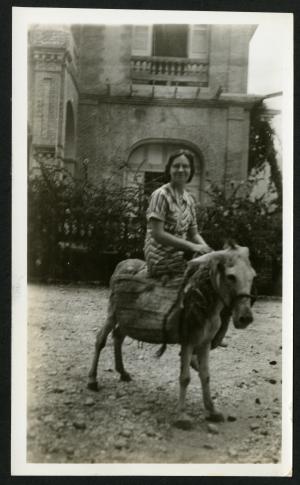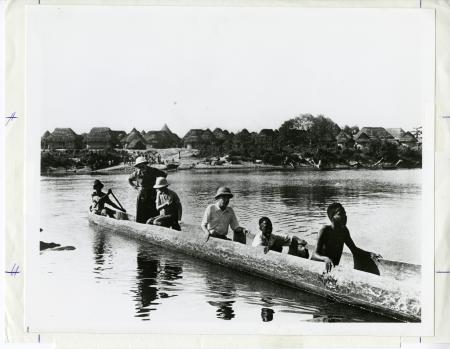For many scientists working with the Smithsonian (both from the Institution’s earliest days and today), their studies took them all over the world—through the mountains and valleys of the United States, across the continent of Africa, on the shores of Caribbean Islands, and everywhere in between. This meant that many of the Smithsonian’s best scientists were actually part of a scientific couple—inquisitive husbands and wives exploring the world together and making important scientific breakthroughs along the way. In celebration of Valentine’s Day, we’re taking a look at some intrepid scientific couples from the Archives.
Vernon and Florence Bailey
In the Wild Animals of Glacier National Park, published in 1918, the text is split in two, the mammals and the birds, written by two different scientists. It was a merging of focus areas for two remarkable scientists with something important in common beyond their work—a marriage. Vernon Orlando Bailey, a naturalist and mammologist, married ornithologist Florence Augusta Merriam Bailey in 1899. Before they took to the field together, both Bailey’s had successful and established careers in science.
Florence, an avid bird conservationist, became interested in studying birds in the field (as opposed to the taxidermy study popular in her era) during college. At just 26, she had published her first field guide, Birds Through an Opera-Glass. Several others, from field guides to travel books, followed. Florence later became both the first woman associate member of the American Ornithologist’s Union and its first woman fellow.
When Vernon and Florence married in 1899, Vernon was working as the Chief Field Naturalist for the United States Bureau of Biological Survey. He began his relationship with the Bureau, however, when he was just a boy, growing up on the Minnesota frontier. Vernon had often sent specimens he found to the Bureau of Biological Survey, and at 23 became a field agent with the department.
After their marriage, the Bailey’s continued excelling in their respective fields. Vernon became President of the American Society of Mammologists in 1933. Florence published what became a defining text in the ornithology field, Handbook of Birds in the Western United States, in 1902. They conducted field work both independently and together, collaborating on scientific articles and texts, including their study of Glacier National Park. The Bailey name is also attached to something else—a mountain. Mount Bailey, in Oregon, was named after Florence and Vernon.
William and Lucile Mann

William M. Mann, an entomologist and the Zoo director from 1925-1956, spent decades traveling the world with his wife, Lucile Quarry Mann. The traveled across the African continent, through Europe and South America, doing everything from conducting field expeditions, to collecting animals, to meeting with other prominent zoologists abroad—working together as a team on behalf of the Zoo.
When William and Lucile met, Lucile was working as an editor for the U.S. Department of Agriculture’s Bureau of Entomology. One day, Lucile had to fact check a manuscript at the library in the National Museum of Natural History, and she worked at a desk right near her future husband. It wasn’t until several years later, when Lucile was working as an editor for Ladies Home Companion in New York and Mann was the newly named Zoo director, that they reconnected. William proposed to Lucile before he set sail on an expedition to East Africa in 1925. The Mann’s spent the next several decades on expedition together, each of them writing books about their work and experiences.
“Being married to a general, all-around naturalist is a better education than passing A in Zoology I,” Lucile wrote in her book, From Jungle to Zoo: Adventures of a Naturalist’s Wife, which she dedicated to Bill. She said that her husband genuinely loved his work, and “liked [it] with an enthusiasm that swept me past the initial difficulties of scientific terminology,” and her early aversion to reptiles. She reflects that, thanks to years of adventures and research with her husband, she was “grateful all over again for life on the edge of the Zoo” (and even conceded that “Snakes make good pets—once you get accustomed to the idea.”).
Richard and Ruth Blackwelder
 Biologist and entomologist Richard E. Blackwelder married his wife, Ruth, in January 1935 and by June the new Mr. and Mrs. Blackwelder had set sail for Jamaica—though not for a honeymoon. Blackwelder had been appointed as a Travelling Scholar for the Smithsonian, a position which kept the new couple in the West Indies for another three years.
Biologist and entomologist Richard E. Blackwelder married his wife, Ruth, in January 1935 and by June the new Mr. and Mrs. Blackwelder had set sail for Jamaica—though not for a honeymoon. Blackwelder had been appointed as a Travelling Scholar for the Smithsonian, a position which kept the new couple in the West Indies for another three years.
Not much is known about Ruth Blackwelder, but both her and Richard’s diaries from their time abroad hint at the difficulties of the couple’s abrupt upheaval to Jamaica. Ruth writes about needing to get “over the sea legs we had acquired” after a long journey on the ship, and the cultural differences she encounters, like missing out on Fourth of July celebrations, or not knowing how to best give a cab driver an address. At the beginning of her diary, she notes that “It seems difficult to realize that a [local] family which has as many modern things as an all wave radio (newest style), gas range, and automobile would be without the convenience of hot running water.”
Ruth was an avid stamp collector, and her time abroad helped expand her collection. Richard also writes about Ruth collecting shells, and helping him find specimens. Later, Ruth would go on to collaborate on books and articles with her husband, including the Directory of Zoological Taxonomists of the World in 1961. By then, the Blackwelders were stationed back in the United States—Richard went on to have a curatorial career at the now National Museum of Natural History before becoming a Professor of Zoology at Southern Illinois University until his retirement in 1977.
Related Resources
Who Was Ruth MacCoy Blackwelder?, The Bigger Picture Blog, Smithsonian Institution Archives
A Life on the Wild Side: Lucile Quarry Mann, The Bigger Picture Blog, Smithsonian Institution Archives
A Beaver Corral, Fried Owl, and Pueblos: Adventures with Vernon Orlando Bailey, The Bigger Picture Blog, Smithsonian Institution Archives
Outstanding Women in Ornithology: Florence Merriam Bailey, The Bigger Picture Blog, Smithsonian Institution Archives
Produced by the Smithsonian Institution Archives. For copyright questions, please see the Terms of Use.


Leave a Comment